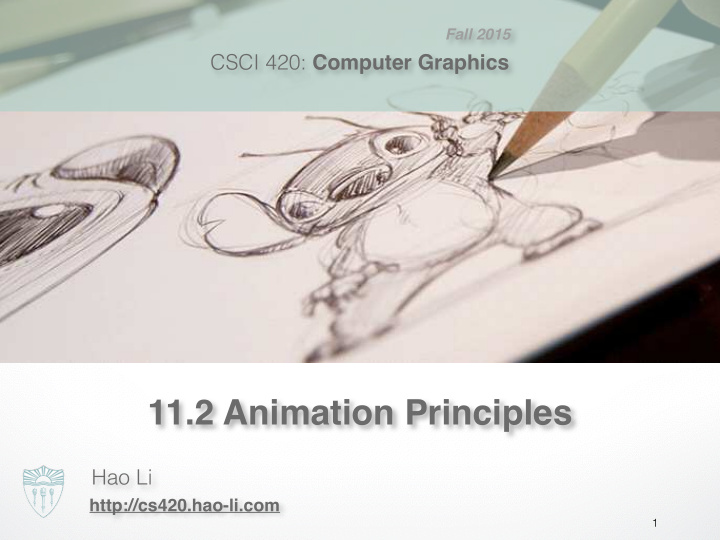



Fall 2015 CSCI 420: Computer Graphics 11.2 Animation Principles Hao Li http://cs420.hao-li.com 1
Additional Reading Rango: Character Walking Tests
Computer Animation • Models have parameters: – polygon positions, normals, – – spline control points, – joint angles, camera parameters, – – lights, – color, etc. n parameters define an n -dimensional state space • Values of n parameters = point in state space •
Computer Animation • Animation defined by path through state space • To produce animation: 1. start at beginning of state space path 2. set the parameters of your model 3. render the image 4. move to next point along state space path, 5. Goto 2. • Path usually defined by a set of motion curves (one for each parameter) • Animation = specifying state space trajectory
Additional Reading
Animation “Bring things to life.” Sequence of images that give perception of movement when played in rapid succession Film: 24 fps, explorations in high frame-rate movies (48/60 fps) • Video: 30 fps • ~130K images for a 90 min movie
Traditional Animation Film runs at 24 frames per second (fps) • – That’s 1440 pictures to draw per minute – 1800 fpm for video (30fps) • Productions issues: – Need to stay organized for efficiency and cost reasons – Need to render the frames systematically • Artistic issues: – How to create the desired look and mood while conveying story? – Artistic vision has to be converted into a sequence of still frames – Not enough to get the stills right--must look right at full speed • Hard to “see” the motion given the stills • Hard to “see” the motion at the wrong frame rate
High Frame Rate Filming
Animation
Animation
Animation
Animation • Key frames – Important frames – Motion-based description – Example: beginning of stride, end of stride • Inbetweens: draw remaining frames – Traditionally done by (low-paid) human animators
Layered Motion • It’s often useful to have multiple layers of animation – How to make an object move in front of a background? – Use one layer for background, one for object – Can have multiple animators working simultaneously on different layers, avoid re-drawing and flickering • Transparent acetate allows multiple layers – Draw each separately – Stack them on a copy stand – Transfer onto film by taking a photograph of the stack
Geri’s Game
Character Animation
Character Animation
Geri’s Game: Subdivision Surfaces
Animation Principles
Luxo Jr.
Squash and Stretch
Squash and Stretch
Timing
Timing
Anticipation
Follow Through
Follow Through
Staging
Ease-In and Ease-Out
Arcs
Exaggeration
Secondary Action
Secondary Action
Appeal
Personality
Principles of Traditional Animation • Stylistic conventions followed by Disney’s animators and others (but this is not the only interesting style, of course) • From experience built up over many years – Squash and stretch -- use distortions to convey flexibility – Timing -- speed conveys mass, personality – Anticipation -- prepare the audience for an action – Followthrough and overlapping action -- continuity with next action – Slow in and out -- speed of transitions conveys subtleties – Arcs -- motion is usually curved – Exaggeration -- emphasize emotional content – Secondary Action -- motion occurring as a consequence – Appeal -- audience must enjoy watching it
Further Reading
Computer-Assisted Animations • Computerized Cel painting – Digitize the line drawing, color it using seed fill – Eliminates cel painters – Widely used in production (little hand painting any more) – e.g. Lion King • Cartoon Inbetweening – Automatically interpolate between two drawings to produce inbetweens (similar to morphing) – Hard to get right • inbetweens often don’t look natural • what are the parameters to interpolate? Not clear... • not used very often
Computer Animation • Generate images by rendering a 3D model • Vary parameters to produce animation • Brute force – Manually set the parameters for every frame – 1440n values per minute for n parameters – Maintenance problem • Computer keyframing – Lead animators create important frames – Computers draw inbetweens from 3D(!) – Dominant production method
http://cs420.hao-li.com Thanks! 39
Recommend
More recommend